01-语言学导论
- 格式:ppt
- 大小:4.88 MB
- 文档页数:54
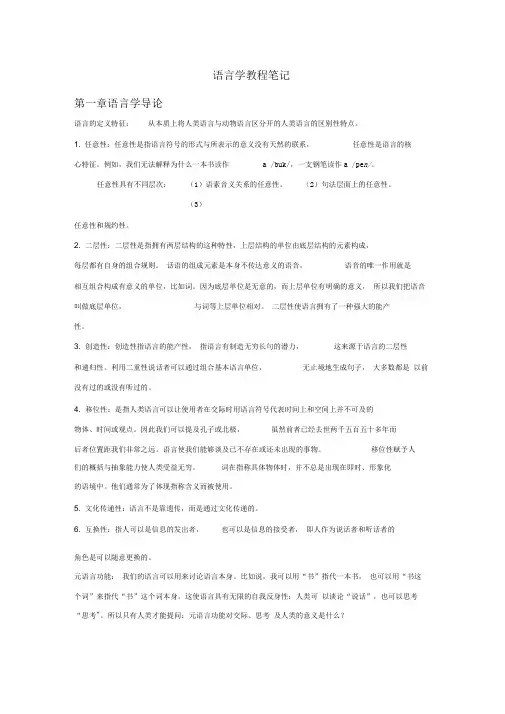
语言学教程笔记第一章语言学导论语言的定义特征:从本质上将人类语言与动物语言区分开的人类语言的区别性特点。
1. 任意性:任意性是指语言符号的形式与所表示的意义没有天然的联系,任意性是语言的核心特征。
例如,我们无法解释为什么一本书读作 a /buk/,一支钢笔读作a /pe n/。
任意性具有不同层次:(1)语素音义关系的任意性。
(2)句法层面上的任意性。
(3)任意性和规约性。
2. 二层性:二层性是指拥有两层结构的这种特性,上层结构的单位由底层结构的元素构成,每层都有自身的组合规则。
话语的组成元素是本身不传达意义的语音,语音的唯一作用就是相互组合构成有意义的单位,比如词。
因为底层单位是无意的,而上层单位有明确的意义,所以我们把语音叫做底层单位,与词等上层单位相对。
二层性使语言拥有了一种强大的能产性。
3. 创造性:创造性指语言的能产性,指语言有制造无穷长句的潜力,这来源于语言的二层性和递归性。
利用二重性说话者可以通过组合基本语言单位,无止境地生成句子,大多数都是以前没有过的或没有听过的。
4. 移位性:是指人类语言可以让使用者在交际时用语言符号代表时间上和空间上并不可及的物体、时间或观点。
因此我们可以提及孔子或北极,虽然前者已经去世两千五百五十多年而后者位置距我们非常之远。
语言使我们能够谈及已不存在或还未出现的事物。
移位性赋予人们的概括与抽象能力使人类受益无穷。
词在指称具体物体时,并不总是出现在即时、形象化的语境中。
他们通常为了体现指称含义而被使用。
5. 文化传递性:语言不是靠遗传,而是通过文化传递的。
6. 互换性:指人可以是信息的发出者,也可以是信息的接受者,即人作为说话者和听话者的角色是可以随意更换的。
元语言功能:我们的语言可以用来讨论语言本身。
比如说,我可以用“书”指代一本书,也可以用“书这个词”来指代“书”这个词本身。
这使语言具有无限的自我反身性:人类可以谈论“说话”,也可以思考“思考"。

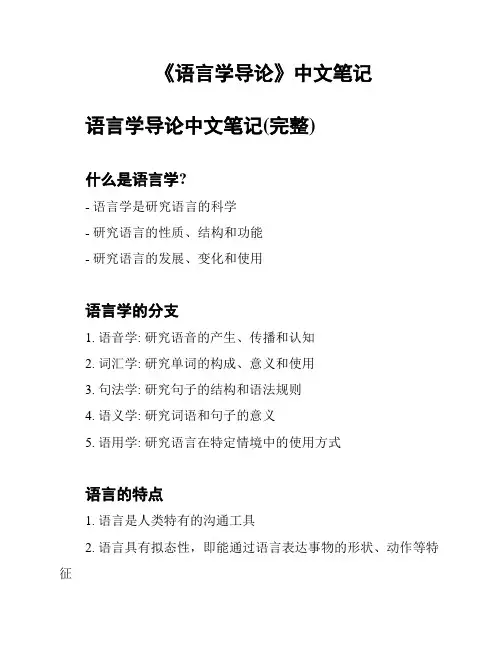
《语言学导论》中文笔记语言学导论中文笔记(完整)什么是语言学?- 语言学是研究语言的科学- 研究语言的性质、结构和功能- 研究语言的发展、变化和使用语言学的分支1. 语音学: 研究语音的产生、传播和认知2. 词汇学: 研究单词的构成、意义和使用3. 句法学: 研究句子的结构和语法规则4. 语义学: 研究词语和句子的意义5. 语用学: 研究语言在特定情境中的使用方式语言的特点1. 语言是人类特有的沟通工具2. 语言具有拟态性,即能通过语言表达事物的形状、动作等特征3. 语言具有符号性,即语言中的单词和语法符号代表着特定的意义4. 语言是可以研究和教授的,通过语言能够传递文化和知识语言的功能1. 意指功能: 通过语言表达思想、情感和意图2. 表示功能: 通过语言描述和描绘事物、现象和过程3. 交际功能: 通过语言实现沟通和交流4. 记忆功能: 通过语言记录和传递信息5. 心理功能: 通过语言影响和塑造个体的心理活动语言与文化- 语言是文化的一部分,反映了社会和文化的价值观和观念- 不同的语言体现了不同的文化方式和思维方式- 语言的变化和发展与文化的变迁和演变相互关联语言的变化和发展- 语言是动态的,不断发展和变化- 语言变化的原因包括:社会文化变迁、语言接触和语言演化- 语言变化常常由语言使用者的创新和共同接受推动语言的使用- 语言使用涉及语言使用者的语法知识、语境理解和交际目的- 语言的使用方式受到社会、文化、地域等因素的影响- 语言的使用也受到个体因素和语言使用者之间的关系影响以上是《语言学导论》的简要笔记,介绍了语言学的定义、分支、特点、功能、与文化关系、变化和使用等方面的内容。
对于进一步学习语言学的人来说,这份笔记能够提供一个全面的概览,并为深入研究打下基础。
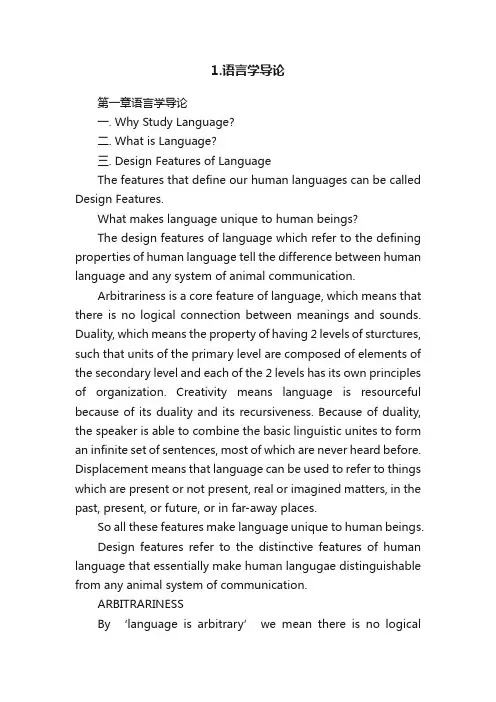
1.语言学导论第一章语言学导论一. Why Study Language?二. What is Language?三. Design Features of LanguageThe features that define our human languages can be called Design Features.What makes language unique to human beings?The design features of language which refer to the defining properties of human language tell the difference between human language and any system of animal communication.Arbitrariness is a core feature of language, which means that there is no logical connection between meanings and sounds. Duality, which means the property of having 2 levels of sturctures, such that units of the primary level are composed of elements of the secondary level and each of the 2 levels has its own principles of organization. Creativity means language is resourceful because of its duality and its recursiveness. Because of duality, the speaker is able to combine the basic linguistic unites to form an infinite set of sentences, most of which are never heard before. Displacement means that language can be used to refer to things which are present or not present, real or imagined matters, in the past, present, or future, or in far-away places.So all these features make language unique to human beings.Design features refer to the distinctive features of human language that essentially make human langugae distinguishable from any animal system of communication.ARBITRARINESSBy ‘language is arbitrary’ we mean there is no logicalconnection between meanings and sounds. For example, there is no reason why English speakers use the sounds /dog/ to denote the animal ‘dog’, or /pig/ to refer to the animal ‘pig’ while Chinese speakers use different sounds (狗and 猪respectively) to indicate them. There are different levels of arbitrariness.(1) Arbitrary relationship between the sound of a morpheme and its meaning.We must admit that there are certain words with different degrees of onomatopoeia in every language which imitate natural sounds, such as ‘bang, crash, and roar’ in English, and ‘叮叮当,咔嚓,扑哧’ in Chinese. However arbitrariness and onomatopoeic effect may work at the same time. Widdowson’s illustration of a line ‘The murmurous haunt of flies on summer eves’ in Keats’Ode to a Nightinggale by attempting the s ubstitution of ‘murderous’ for ‘murmurous’ shows that no connection will be established between sounds and the little noiseness of the flying flies. ‘It is only when you know the meaning that you infer that the form is appropriate.’(Widdowson, 1996:6)(2) Arbitrariness at the syntactic levelAs to arbitrariness at the syntactic level, there are 2 opposite points of view.According to some functional linguists (Halliday, 1985/1994), language is not arbitrary at the syntactic level because there may be a certain degree of correspondence between the sequence of clauses and the real happenings. Put it differently, syntax is less arbitrary than words, especially in so far as word order is concerned. Compare: a). He came in and sat down. b). He sat down and came in. c). He sat down after he came in. Sentence a) means the actions occurred in this order. Sentence b) means theopposite sequence of the real happening—perhaps he got into his wheelchair and propelled himself into the room. In sentence c) with the help of the word ‘after’ we can reverse the order of the clauses.However, formal linguists underscore the autonomy of syntax. ‘Human cognition embodies a system whose primitive terms are non-semantic and non-discourse-derived syntactic elements and whose principles of combination make no reference to system-ext ernal factors.’ (Newmeyer, 1998:18) in other words, to them, syntax is purely arbitrary.(3) Arbitrariness and ConventionArbitrariness and Conventionality are 2 indispensable sides of the coin of language. Arbitrariness of language makes it potentially creative, and conventionality of languge makes learning a language laborious.DUALITYDuality is one of the characteristics of human language. It refers to the fact that language has 2 levels of structures, such that units of the primary level (words) are composed of elements of the secondary level (sounds) and each of the 2 levels has its own principles of organization.For example, a syllable is the smallest unit that is normally spoken by itself, and scores of syllables become the carriers of hundreds of meaningful segments of words that are called morphemes.Why do people take duality as one of the important design fuatures of human language? Can you tell us what language will be if it has no such desine feature?Duality makes our language productive. A large number of different units can be formed out of a small number of elements.For example, tens of thousands of words out of a small set of sounds. And out of the huge number of words, there can be astronomical number of possible sentences and phrases, which in turn can combine to form unlimited number of texts. Most animal communication systems do not have this design feature of human language.If language had no such design feature, then it would be like animal communicational system which consists only a number of basic sounds and this would be highly limited. Then we would not be able to produce a very large number of sound combinations (e.g. words), which are distinct in meaning. In other words, the number of messages one can send woud be restricted to the number of basic sounds.CREATIVITYOne of the design features of human language is creativity. What is it? And what makes it possible?By Creativity, we mean language is resourceful because of its duality and recursiveness. It is one of the design features that only human language has.Human language is resourceful because of its duality and its recursiveness. The speaker is able to combine the basic linguistic units to form an infinite set of sentences, most of which are never before produced or heard. The recursive nature of langugae provides a theoretical basis for creating endless sentences.DISPLACEMENTHuman languages enable their users to symbolize objects, events and concepts which are not present (in time and space) at the moment of communication. This quality is labeled as displacement.For example, we can talk about Hitler, who is already dead;we can even talk about next week, which is in the future.‘An refer to Confucius even though he was dead 2000 years ago.’ This shows that language has the design feature of displacement.四. Origin of LanguageTheory that primitive man made involuntary vocal noises while performing heavy work has been called the Yo-he-yo theory.The Bow-wow theory is a theory on the origin of language.五. Functions of LanguageWhat are the 7 functions of human language?According to Hu Zhuanglin, language has at least 7 functions, and they are illustrated as follows:(1)INFORMATIVE FUNCTION: it means that language is the instrument of thought and languageserves an informational function when used to tell something. It is also called ideational function in the framework of functional grammar. The declarative sentences such as ‘This is a book.’ are the typical illustration of this function.(2)INTERPERSONAL FUNCTION: it means people can use language to estabilish and maintaintheir status in a society. It is the most important sociological use of language. In the framework of functional grammar, this function is concerned with interaction between the addresser and addressee in the discourse situation and the addresser’s attitude toward what he speaks or writes about. For example, the ways in which people address others and refer to themselves (such as Dear Sir, Dear Professor, Johnny, yours, your obedient servant) indicate the various grades of interpersonal relations.(3)PERFORMATIVE FUNCTION: it is primarily to change thesocial status of persons, as inmarriage ceremonies, the sentencing of criminals, the blessing of children, the naming of a ship at a launching ceremony, and the cursing of enemies. The kind of language employed in performative verbal acts is usually quite formal and even ritualized. The performative function can extend to the control of reality as on some magical or religious occasions. For example, in Chinese when someone breaks a bowl or a plate, the host or the people present are likely to say 碎碎平安(every year be safe and happy) as a means of controling the forces which the believers feel might affect their lives.(4)EMOTIVE FUNCTION: it is one of the most powerful uses of language because it is so crucialin changing the emotional status of an audience for or against someone or something. It is a means of getting rid of the nervous energy when people are under stress, for example, swear words, obscenities, involuntary verbal reactions to beautiful art or scenery; conventional words/phrases, for example, God, My, Damn it, Wow, Ugh, Ow, etc.(5)P HATIC COMMUNION: it originates form Malinowski’s study of the functions of languageperformed by Trobrind Islanders. It refers to the social interaction of language . People always use some small, seemingly meaningless expressions such as ‘Good morning, Go d bless you, Nice day, etc.’ to maintain a comfortable relationship between people without any factual content.(6)RECREATIONAL FUNCTION: it means people use language for the sheer joy of using it, such asa baby’s babbling or a chanter’s chanting.(7)METALINGUAL FUNCTION: it refers to the fact that peoplecan use language to talk aboutitself. For example, I can use the word ‘book’to talk about a book, and I can also use the expression ‘the word book’ to talk about the sign ‘b-o-o-k’ itself.六. What is Linguistics?Linguistics is usually defined as the science of language or the scientific study of language.七. Main Branches of LinguisticsPHONETICS and PHONOLOGYPhonetics mainly studies the characteristics of speech sounds and provides methods for their description, classification and transcription.The branch of linguistics which studies the sound patterns of a language is called phonology.Illustrate the significance of studying speech sounds in linguistics.Language is first and foremost a ‘system of vocal symbols’. Human beings are capable of making all kinds of sounds, but only some of these sounds have become units in the language system, as we have seen in the discussion of language speech sounds had existed long before writing was invented, and even today, in some parts of the world, there are still languages that have no writing systems. Therefore, the study of speech sounds is a major part of linguistics.Analysis of speech sounds can be approached on 2 levels: phonetics and phonology. Phonetics deals with speech organs and their functions, speech sounds, waves carrying speech sounds, analysis and processing of the sounds by the listener. Phonology is concerned with the organization of speech within specific languages, or with the systems and patterns of soundsthat occur in particular languages. Both phonetics and phonology are main branches of linguistics.To study speech sounds, linguistics need to analyze the minute processes and acticities of the speaker and explain the way speech organs move to convey meaning. The theory and methods thus developed can be applied to numerous other fields. For example, people who work in recording, language description and language teaching will have some interest in phonetic knowledge while those who work in audiology, speech therapy and speech pathology must have a solid foundation in phonetics and phonology.MORPHOLOGYThe branch of grammar which studies the internal stucture of words is called Morphology.SYNTAXThe branch of grammar which studies the internal structrue of sentence is called Syntax.In linguistics, Syntax refers to the study of the rules governing the way words are combined to form sentences in a language, or simply, the study of the formation as sentence.SEMANTICS and PRAGMATICSSemantics and pragmatics investigate different aspects of linguistic meaning.Pragmatics can be defined as the study of language in use.Is it possible to separate semantics and pragmatics?Though both semantics and pragmatics have to do with the meaning of language, and link language to the world, we think it is possible to separate semantics and pragmatics in linguistic study.Semantics is the study of literal meaning of linguisticexpressions, particularly meaning of words, phrases and sentences. In using the term sense rather than reference, the focus of semantics is on the way people relate words to each other within the framework of their language. Pragmatics starts from the observation that people use language to accomplish many kinds of acts, broadly known as speech acts thus it is the study of how to do things with words or of the meaning of language in context. This kind of meaning in pragmatics usually refers to as speaker’s meaning, utterence meaning, or contextual meaning. Its interpretation depends more on who the speaker of the sentence is, who the hearer is, when and where it is used.Thus the distinction between semantics and pragmatics is clear: the former is more closely related to the words used, the more constant, inherent side of meaning; the later is more closely related to the context, the more indeterminate side, or something extra.八. MacrolinguisticsMacrolinguistics studies how linguistics is related with other disciplines such as psychology, sociology, ethnography, the science of law and artificial intelligence etc.Psycholinguistics is concerned primarily with investigating the psychological reality of linguistic structures.Sociolinguistics is an umbrella term which covers a variety of different interests in languge and society, including the social functions of langugae and the social characteristics of its users. It attempts to show the relationship between language and society.九. Important Distinctions in LinguisticsDESCRIPTIVE vs. PRESCRIPTIVEDescriptive study attempts to tell what is in the language,while Prescriptive study tells people what should be in the language. Most comtemporary linguists believe that whatever occurs naturally in the language should be described.An approach in linguistic study which attempts to lay down rules of correctness as to how language should be used is Prescriptive.Modern linguistic is Descriptive in the sense that the linguist tries to discover what language is rather than lay down some rules for people to observe.SYNCHRONIC vs. DIACHRONICThe description of a language as it changes through time is a diachronic linguistic study. Diachrony is concerned with the evolution of language over time.The study of language at one point in time is a Synchronic study.Synchrony refers to the state of a language as it exists at any given time.LANGUE /PAROLE and COMPETENCE/PERFORMANCESaussure puts forward the concept of Langue and Parole, and Chomsky puts forward the concept of Competence and Performance. Please dwell upon the differences and similarities, if any, of the 2 pairs: Langue and Parole vs. Competence and Performance.According to F. de Saussure, Langue refers to the abstract linguistic system shared by all members of a speech community; while Parole refers to the realization of langue in actual use. We can compare them along the following dimensions: Langue is abstract; Parole is specific to the situation in which it occurs. Langue is not actually spoken by someone; Parole is always a naturally occurring event. Langue is relatively stable andsystematic; Parole is subject to personal and situational constraints. The linguists’proper object is the Langue of each community, the lexicon, grammar and phonology implied in each individual by his upbringing in society, and on the basis of which he speaks and understands his language.For Chomsky, a fundamental distinction between linguistic Competence and Performance should be made. A language user’s underlying knowledge about the system of rules is called linguistic Competence. And Performance refers to the actual use of language in concrete situations. In light with this, Competence enables a speaker to produce and understand an indefinite number of sentences and to recognize grammatical mistakes and ambiguities. A speaker’s Competence is stable but his Performance is often influenced by psychological and social factors, and thus would involve imperfections such as slips of tongue, false starts, unnecessary pauses, and so on. Thus, the point is that a speaker’s Performance does not always match his Competence.Sauss ure’s distinction is somewhat similar with Chomsky’s in the sense that the both refer to the constant factor which underlies the utterances that constitute Parole/Performance. However, their difference is quite obvious. Saussure’s Langue is a social product, a set of conventions for aspeech community. Chomsky regards Competence as a property of the mind of each individual. Saussure looks at Language more from a sociological point of view while Chomsky looks at it more from a psychological point of view.Li nguistic potential is similar to Saussure’s langue and Chomsky’s competence.。
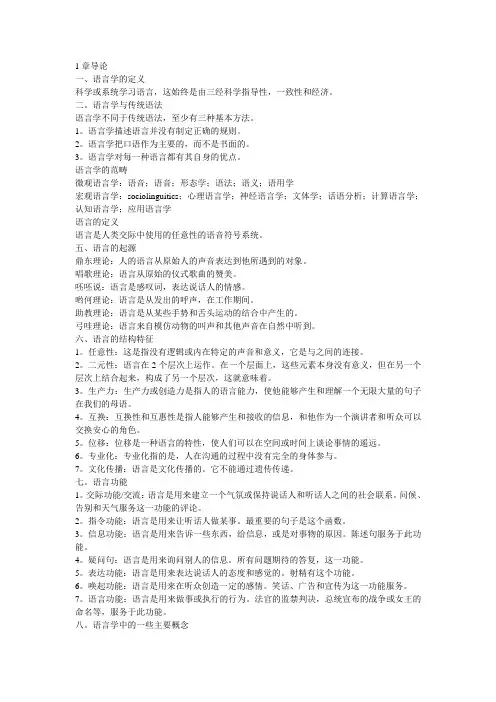


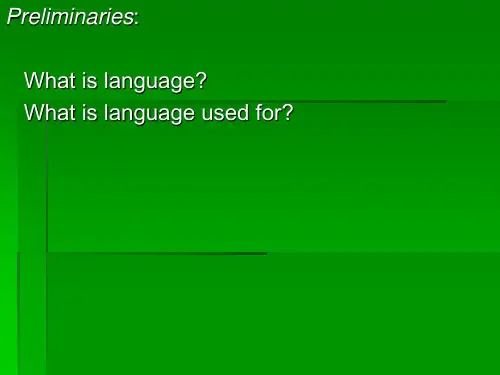

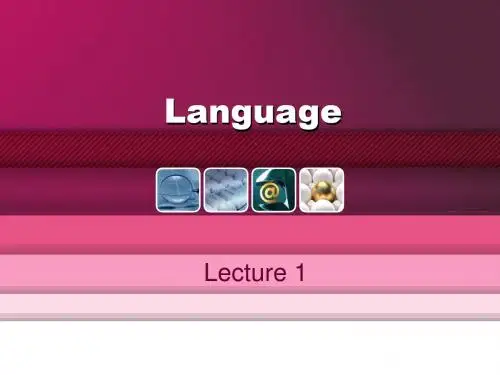
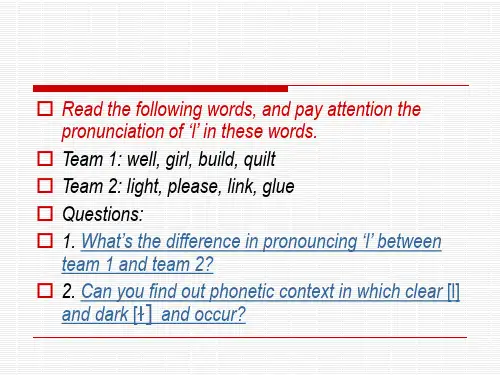
【语言学】语言学是以语言为研究对象的科学。
【“小学”】“小学”是中国传统的语文学,围绕解释和解读先秦典籍来展开研究,从而诞生了分析字形的文字学、研究字音的音韵学、解释字义的训诂学。
因此又被人们称为经学的附庸。
【思维】思维是认识现实世界时的动脑筋的过程,也指动脑筋时进行比较、分析、综合以认识现实的能力。
【符号】符号是由一定的形式构成的表示一定意义的记号或标记,包括形式和意义两个方面,其作用是指称现实现象。
【语言符号】语言符号是由音、义结合构成的,能代表或指称现象。
“音”是语言符号的物质表现形式,“义”是语言符号的内容,只有音和义结合才能指称现实现象,构成语言的符号。
【征候】征候是事物本质的特征,它代表着事物,可以让我们通过它来推知事物。
【组合规则】构成线性序列的语言成分之间的结构关系,就是说,语言符号的单位互相组合为一个更大单位的规则。
【聚合规则】在同一个结构位置上不同结构单位的替换规则。
【音标】记录音素的标写符号。
【国际音标】国际语音协会指定的一套记音符号,是用来记录各民族语言的语音的。
国际音标符合“一个音素一个符号,一个符号一个音素”的原则。
【音位学】音位学是在了解语音的物理、生理特性的基础上从语言的社会功能的角度对语音的研究。
【音素】音素是人类语言从音质角度划分出来的最小的语音单位。
【清音、浊音】清音、浊音是语音中的发音特点。
辅音的发音体是阻碍气流的发音部位,但有时声带也参与发音。
发音时声带颤动的辅音叫浊辅音,不颤动的叫清辅音。
【音质音位】以音素为材料,从音质的角度分析的音位,叫做音质音位。
【非音质音位】有区别词的语音形式作用的音高、音重、音长叫做非音质音位。
【调位】有区别词的语音形式作用的音高变化,叫做调位。
【重位/势位】能区别词的语音形式的重音叫做重位或势位。
【时位】能区别词的语音形式的元音的长短叫时位。
【音位变体】处于互补关系中的各个音素被看成是同一个音位在不同位置上的代表,是同一个音位的不同的变异形式,我们把它们叫做音位变体。
语言学导论
语言学的兴起可追溯到17世纪,康德和韦伯等学者尝试建立一套完整的语言理论,其中最重要的理论提出是语素理论和变位主义。
此后的18世纪,语言学的发展受到新古典学派的影响,如莱恩、民族文学等,把语言学发展成为’科学’,它的形成依靠对比研究和分类研究。
随着19世纪新观念的进入,人们开始关注语言学的实用性和抽象性。
布鲁姆和莱恩是20世纪初期最重要的语言学家,他们通过实验和实证获得了一系列有关语言性质的结论。
他们另一个革命性的成果是语言心理学和语言行为研究,语言学领域也从此大有开展,芬兰语学,祖辈影响研究,社会语言学,凝聚论,生物学和语言及社会翻译学等都大有发展。
20世纪50年代,普遍性语言学理论概念得以显现,人们对语言本质及其进化机制产生了新的兴趣。
这一理论引导语言学乘着研究方法和结构层次的探索的便捷的船只。
有了这一理论,美国研究者开始大量地应用语言学原理研究大规模的非洲方言语言,而后随之又出现了包括语言规范学,非言语交流学,语言文化学,社会动态语言学及语言政策研究等一系列新领域,语言学的发展脚步又进一步加快。
到了20世纪末,语言学理论发展到了一个新的阶段。
在理论上,语言学家开始把大量的解释及主观性要素投射到其研究对象上,研究者分析研究语言的方向从系统介绍了结构派语言学的理论的实证研究来赢得语言的结构。
此外,对语言的分析从比较和系统化的研究而实验和实用性研究,一门融合式语言学也得以成立,加快语言学理论的发展。
研究工作也涉及到更广泛的范围,例如世界语言学、多样性语言学,以及社会文化语言学等。
未来,语言学家们将不断重新建构语言学的理论,更新其研究结果,深化对语言的研究。
《语言学导论》教学大纲一、课程基本信息二、课程性质、地位和任务本课程以英语专业高年级学生为主要对象,属英语专业知识课程之一,是选修其他语言学分支课程的先决条件,也是选修其他综合文化素质课程的基础。
三、课程基本要求本课程将为人类语言本质的基本问题提供一些解答,使学生了解人类语言研究的丰富成果,提高其对语言的社会、人文、经济、科技以及个人修养等方面重要性的认识,以多种方式让学生体会领悟人类语言是一个极度复杂却仍有规可循的、迷人的心智系统,向学生展示语言学和其他学科如心理学、社会学、哲学等学科间的关系如何日趋密切以致最终逐渐发展成了一门内容浩瀚、涉及面广的交叉科学。
在对语言和语言使用的方方面面进行科学、系统的分析探讨过程中,着意培养学生的语言意识和研究兴趣,使其善于对语言现象进行观察和思考,提高语言使用和研究能力,发展以概念分析为基本的逻辑思维习惯,培养提高科学分析问题的能力和辩证的理性思维,全面提高素质。
具体而言,通过本课程的学习,学生能初步了解或掌握语言学的基本知识,了解语言的本质、功能和机制,掌握语言的语音、词汇、语法、语义规律,认识语言与社会、文化、思维、认知、语言习得等的关系,学会分析语料,了解如何进行语言学研究,由此为进一步的语言学习或研究奠定基础。
尤其是,通过本课程的学习,学生能了解语言的本质、掌握语言习得、特别是外语的教与学的实质及相关研究的科学成果,领会语言学各个层面的科研进展对外语教学的启示,以便更好地从事英语学习和教学。
四、课程内容及学时分配本课程包括:课程导学、引言、语音学与音位学、形态学、句法学、语义学、语用学、话语分析、社会语言学、文体学、心理语言学、认知语言学和应用语言学等共十三个部分。
各部分内容之间有相对的独立性,又存在有机的联系。
授课时间为一学期共18周,每周授课一次两个学时,共计36个学时。
具体课程内容与学时分配如下(各部分所列详细内容为其要点内容):第一部分课程导学(Course Guide),1学时:为何要学语言学?如何学?教学规划第二部分导言(Preliminaries),2学时:语言的定义、语言的本质特征、语言的功能、语言学的性质及研究范围、语言学简史第三部分语音学与音位学(Phonetics and Phonology),3学时:语音学的范围、英语语音的描述与分类、音素、音位学的范围、音位分析、超音位分析第四部分形态学(Morphology),3学时:词的定义、词位、词素、构词法第五部分句法学(Syntax),3学时:句法研究的性质与范围、词类、转换生成语法、功能句法第六部分语义学(Semantics),3学时:语义学研究范围、词义分析、词之间的意义关系、句子与命题、句子意义分析、句之间的意义关系、语义变化机制第七部分语用学(Pragmatics),3学时:语用学研究范围、指示语、预设、言语行为理论、合作原则、会话含意理论、会话分析第八部分话语分析(Discourse analysis),3学时:话语分析研究范围、信息结构、衔接与连贯、话语标记语、多模态语篇分析、批评话语分析第九部分社会语言学(Sociolinguistics),3学时:社会语言学研究范围、语言变体、语言与性别、语码选择、语言规划、社会语言学研究方法第十部分文体学(Stylistics),3学时:研究范围、文体标记、文体分析的语言学方法、实用文体学第十一部分心理语言学(Psycholinguistics),3学时:语言产生、语言理解、语言习得第十二部分认知语言学(Cognitive linguistics),3学时:范畴与范畴化、概念隐喻、概念转喻、意象图式、识解、象似性第十三部分应用语言学(Applied Linguistics),3学时:二语习得、错误分析、中介语、二语教学、语言测试五、课程教材及主要参考资料教材:文旭,《语言学导论》(Linguistics: An Introduction)。